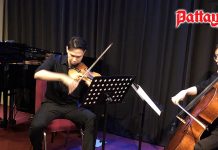In must have been a good many years ago, but my one-and-only journey to Finland was to a music conference in Helsinki. I can’t recall much about the conference but I was amazed by the astronomical prices of everyday goods in the shops. I was also slightly taken aback by the number of drunks in the streets, either staggering about aimlessly or sleeping on the pavement. I tactfully enquired at my hotel why there were so many. “It’s because of the extremely high price of alcohol in Finland” explained the receptionist solemnly, “This makes many people feel depressed and so they drink to overcome the depression.” “Oh, I see,” I replied, not really seeing at all.
Unlike Germany and France, Finland is not known for its long list of classical composers – at least not before the twentieth century. Sibelius of course is generally regarded as the greatest of them all, even though he doesn’t have a Finnish name. His first name is French (and should be pronounced as such) and his last name comes from Latin and is pronounced si-BAY-lee-us, not as sigh-BEE-lee-us as one of my linguistically-challenged friends likes to say.
 Einojuhani Rautavaara. (Photo: Sirpa Räihä)
Einojuhani Rautavaara. (Photo: Sirpa Räihä)
The so-called “Father of Finnish Music” is Fredrik Pacius who was born in 1809 and also sported a Latin-style name despite the fact that he was actually German. Pacius is remembered today as the composer of the Finnish national anthem, the melody of which is also used in the Estonian anthem. He was the composer of the first Finnish opera (1852, since you asked) and he also wrote a violin concerto, a symphony, a string quartet and several other operas.
The composer Armas Jarnefelt achieved modest success with his orchestral works but spent most of his time conducting the Royal Swedish Opera in Stockholm. Selim Palmgren was born in 1878 and became known as “The Finnish Chopin” on account of his vast number of piano compositions, some of which are still popular today. And that’s about it.
Not until the twentieth century did Finnish composers begin to emerge, though few of them have really achieved international fame. The best-known are Sven Einar Englund, Kaija Anneli Saariaho and the dauntingly named Einojuhani Rautavaara.
Einojuhani Rautavaara (b. 1928): Suite for Strings. Burlington Chamber Orchestra, cond. Michael Hopkins (Duration: 14:55; Video: 720p HD)
Let’s get the pronunciation sorted out first. It sounds roughly like AY-no-yoo-hah-nee RAO-ta-vah-ra (in which “RAO” rhymes with “cow”). Now say it ten times slowly, because there will be a test later.
Rautavaara is Finland’s best-known contemporary composer and his music is frequently performed. He’s also incredibly prolific with eight symphonies to his name, three piano concertos, a violin concerto, a harp concerto and clarinet concerto. There’s also a concerto for birds and orchestra in which the orchestral part is enhanced with bird-song recorded by the composer himself.
Many of his works have rather mystic-sounding titles and Rautavaara is considered by many to be a rather contradictory figure whose music cannot easily be categorized in terms of style. In 1955 the Koussewitzky Foundation allowed Sibelius to nominate a young Finnish composer to study in the United States. Sibelius selected Rautavaara who subsequently spent two years at the Juilliard School of Music and also at Tanglewood studying with Roger Sessions and Aaron Copland.
Although in the 1960s Rautavaara went through an avant-garde phase, his 1952 Suite for Strings is a most approachable work. It was originally scored for string quartet but the following year he arranged it for orchestra. The work has echoes of Finnish folk songs and a distinct hint of neo-classical Stravinsky. The middle slow movement has a lovely poignant melody played above a drone bass while the joyful finale is in the form of a lively folk dance.
Jean Sibelius (1865-1957): Lemminkäinen Suite, Op 22. Vienna Philharmonic cond. Franz Welser-Möst Duration: 45:48; Video 720p HD)
This splendid work is not performed often but it offers a wonderful glimpse into the composer’s musical style. It was originally conceived in 1895 as a mythological opera of Wagnerian proportions but Sibelius changed his mind and instead it became a set of four short symphonic poems intended to be performed one after another. He revised the work in 1897 and again in 1937.
The music is based on the heroic adventures of a Finnish mythological character called Lemminkäinen (LEH-min-kay-ee-nen) whose story is told in the Finnish national epic the Kalevala. You don’t need to know details of the convoluted plot to appreciate the work but you’ll probably recognise the second section as The Swan of Tuonela which is often played as a stand-alone concert piece.
It’s a stunningly good performance by a world-class orchestra, given in the concert hall of Helsinki’s impressive Music Centre. Now then, can you say Einojuhani Rautavaara without stumbling over his first name? No, I thought not.




